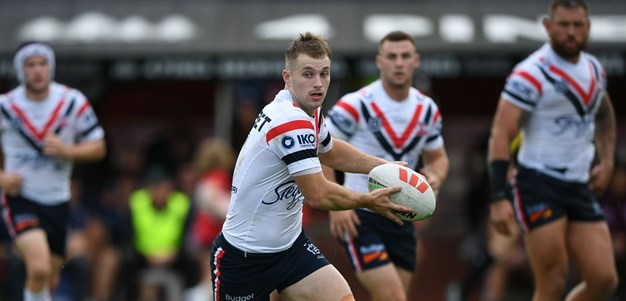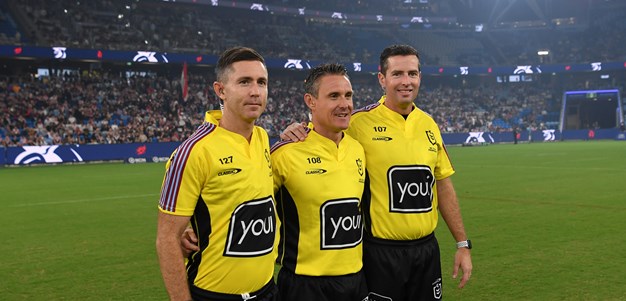Gains… Darcy Lussick (Sea Eagles), Daniel Harrison (Sea Eagles), Kenny Edwards (Southport Tigers), Lorenze Ma’afu (Ipswich Jets).
Losses… Nathan Hindmarsh (retired), Luke Burt (retired), Casey McGuire (retired), Justin Poore (Wakefield), Shane Shackleton (Panthers), Justin Horo (Sea Eagles), Esi Tonga (Sea Eagles).
No club has undergone as big a transformation during the off-season as Parramatta, who have not only farewelled club legends Nathan Hindmarsh and Luke Burt but have essentially cleared the decks with a whole new coaching and training staff and a new CEO (Ken Edwards) to boot.
No club has undergone as big a transformation during the off-season as Parramatta, who have not only farewelled club legends Nathan Hindmarsh and Luke Burt but have essentially cleared the decks with a whole new coaching and training staff and a new CEO (Ken Edwards) to boot.
Key to their much-needed fresh start is head mentor Ricky Stuart, who is renowned as both a strict disciplinarian and a stickler for defensive fortitude – both attributes that the Eels have lacked in recent seasons.
Stuart’s appointment is the biggest coup in Sydney’s west since Brian Smith turned the club’s sagging fortunes around in 1997 and with a licence to do things the way he wants to, Stuart won’t let the boardroom squabbles that so hindered predecessors Stephen Kearney and, more so, Daniel Anderson interfere with his on-field ambitions.
Stuart promises a far more settled club and in doing so has brought along a staff that he knows and trusts to help him achieve it – the likes of assistant coaches Dean Pay and Matt Parish, conditioner Trent Elkin and stats guru Will Badel, to name a few.
But what will this mean for the NRL side in 2013? Given that they have won just 12 of 48 games since the start of the 2011 season, the jury is still out on what they might be able to achieve in the short term.
The departures of Hindmarsh and Burt as well as Casey McGuire and Justin Poore means that experience has taken a hit, with talented but inexperienced youngsters Darcy Lussick and Daniel Harrison from Manly the two notable additions to the squad.
The real interest will centre on the fortunes of fullback Jarryd Hayne and Chris Sandow, who both endured forgettable 2012 seasons (Hayne through injury and Sandow through poor form) but who hold the key to Parramatta’s fortunes.
Stuart will look to ease the pressure on Hayne to win matches by himself, while for Sandow it is about enjoying his footy again. No doubt the former South Sydney playmaker will also benefit from having one of the game’s great halfbacks mentoring him on a day-to-day basis.
Time will tell just how far Stuart can take them in his first year in charge, but with some impressive young talent emerging out wide and a forward pack boasting the likes of Tim Mannah, Fuifui Moimoi and Reni Maitua, they should certainly produce a much-improved season to those they have dished up in the recent past.
How They’ll Play It
It all starts and finishes with defence. Stuart has long been an excellent defensive coach, having pioneered the ruthless and fast-moving defensive line that took the Sydney Roosters all the way to the title in his first year in charge in 2002. He also had Cronulla squeezing the life out of opponents in 2008 before injuries and off-field discretions decimated his squad.
So that will certainly be the goal at Parramatta, who conceded a whopping 28 points per game on average last season – ranking a miserable No.1 for points conceded, tries conceded and metres conceded and second worst for line-breaks conceded as well as missed tackles.
So that will certainly be the goal at Parramatta, who conceded a whopping 28 points per game on average last season – ranking a miserable No.1 for points conceded, tries conceded and metres conceded and second worst for line-breaks conceded as well as missed tackles.
The feebleness of the Eels’ defence last season tended to mask the fact that, on their day, they were one of the more lethal sides in the NRL: who could forget their incredible comeback against Wests Tigers when they went down 31-30 having trailed 31-0 with 13 minutes remaining?
Stuart has promised a sound structure in attack, but with more leeway for players to ‘play what they see’ than they had under Stephen Kearney last season.
Expect a HUGE Year From
Jarryd Hayne. Parramatta’s No.1 attacking weapon ever since his remarkable surge of form in 2009, Jarryd Hayne has only shown glimpses of his scintillating best in recent seasons with injury restricting him to just 12 games in 2012.
Despite constantly coming in and out of the side and missing the last six games of the year after undergoing knee surgery, Hayne still led the way at Parramatta for try assists (12), line-break assists (12) to go with his average 152.7 metres per game.
Having worked with Stuart at Origin level for the past two seasons, he will no doubt enjoy the discipline and passion that the former NSW coach brings to his club football. Any side with a fit and firing Jarryd Hayne will always pose a threat.
Bonus Points
Bonus Points
The Eels have historically been at their best when given licence to attack and their stunning run to the 2009 grand final was based on relentless second-phase play. That all changed over the past few seasons though to the point where in 2012 they found themselves ranked 12th for offloads (9.6 per game) and 16th for tackle-breaks (28.7).
Most notable, however, was the remarkable bursts they too often produced when victory was out of reach and they needed to throw caution to the wind. In Round 8 they trailed Wests Tigers 31-30 with 14 minutes remaining before piling on five quick tries to fall 31-30. It was a similar story against Canberra in Round 10 when they trailed 36-18 but crossed three times in four minutes to come agonisingly close to victory.
Notably, they produced their best form at the back end of the season when caretaker coach Brad Arthur gave them free rein – winning three of their final seven games having previously won just three of 17. The hope is that Stuart will similarly let the side’s natural talents shine in 2013.
The Question Mark
The halves remain somewhat of an unknown quantity and they will need to find both some consistency and stability from their playmakers if they are to make significant strides up the NRL ladder.
Chris Sandow is particularly important. At his best he is a genuine match-winner but his ability to break the line was seen all too rarely last season. The No.6 jersey has also proven somewhat problematic. Stuart has suggested in the past that Jarryd Hayne’s future may well lie in the halves although he is certain to start 2013 in his preferred No.1 jersey. That leaves Ben Roberts and Luke Kelly as the primary contenders to battle it out for a starting spot with neither having managed to make the most of their opportunities last year (although a season-ending injury stalled Kelly’s progress after arriving from Melbourne mid-year).
Who Needs To Lift?
Chris Sandow and Willie Tonga. Last season’s big-name recruits failed to fire – particularly Tonga, who missed most of the pre-season with a pectoral injury and struggled to catch up as the season progressed. A Queensland and Australian representative in 2011, Tonga was a pale imitation of his classy best and scored just one try in his 12 appearances for the Eels.
Likewise, much was expected of Sandow but he struggled to settle into his new surrounds and his moments of magic proved all too rare. Parramatta need both to live up to their profiles in 2013.
How’s Their Depth?
Questionable. At full strength the Eels potentially pose a threat but take away their handful of stars and there isn’t a lot left to get excited about – for now.
The fact of the matter is that the Eels are in the process of re-building and a core element of Stuart’s long-term plan is to nurture junior talent. The club expects to reap the real benefits of their plan in two or three years’ time rather than this season, so a bad run with injury will almost certainly see them struggle.
Dream Team Bankers
The retirement of tackling machine Nathan Hindmarsh means one less big scorer for Eels fans in this year’s NRL Dream Team but Jarryd Hayne remains an excellent bet.
Hayne was the most prolific fullback in the Telstra Premiership in Dream Team 2012 with an average 52 points per game – although his $412,400 price tag will cut into the budget. Nevertheless, the fact that Hayne is certain to start the season in the favoured No.1 jersey rather than shifting into the halves means he can again be relied upon to score heavily.
Hooker Matt Keating was another big scorer last season, with an average 45.67ppg, although he could find himself playing fewer minutes this season given the challenge being mounted by talented youngster Nathan Smith.
Our value tip is halfback Chris Sandow, who averaged a touch over 30ppg last season despite his form woes. If coach Ricky Stuart can turn it all around, Sandow could prove to be a bargain buy at $286,600.
The Coach
Stuart’s job is as safe as houses. He has been ushered to Parramatta with a long-term plan in place and, bar further disasters over the next two years, is almost certain to be given the time he needs to follow through. He also has the comfort of knowing that the Eels have already hit rock bottom, so the only way from here is up.
Under-20s
It’s been a rough few years for the Eels’ Holden Cup squad and, much like the NRL squad, they’ll be hoping a change at the top will help them return to finals football.
Highly rated coach Andrew Webster, who guided Balmain’s SG Ball side to the title last season, takes over from Steve Speechley and although there haven’t been massive changes to the squad, they are expecting a much better finish than last season’s 15th placing.
A number of promising under-20s squad members have spent the pre-season training with the NRL unit with Pauli Pauli, Frazer Masinamua and Tui Kamikamica among the standouts to watch in 2013.
Predicted Finish
Parramatta really are one of the great unknowns of 2013 and much will depend on whether Stuart can instil the defensive discipline and self-belief that has been sorely missed in recent times.
To be honest though, their primary goal in the short term will simply be to make some positive strides forward. A top-eight berth isn’t out of the question but they will need luck with injuries and their big guns to fire. Still, we see them escaping the wooden spoon race this time around. Bracket them 10th to 14th.


